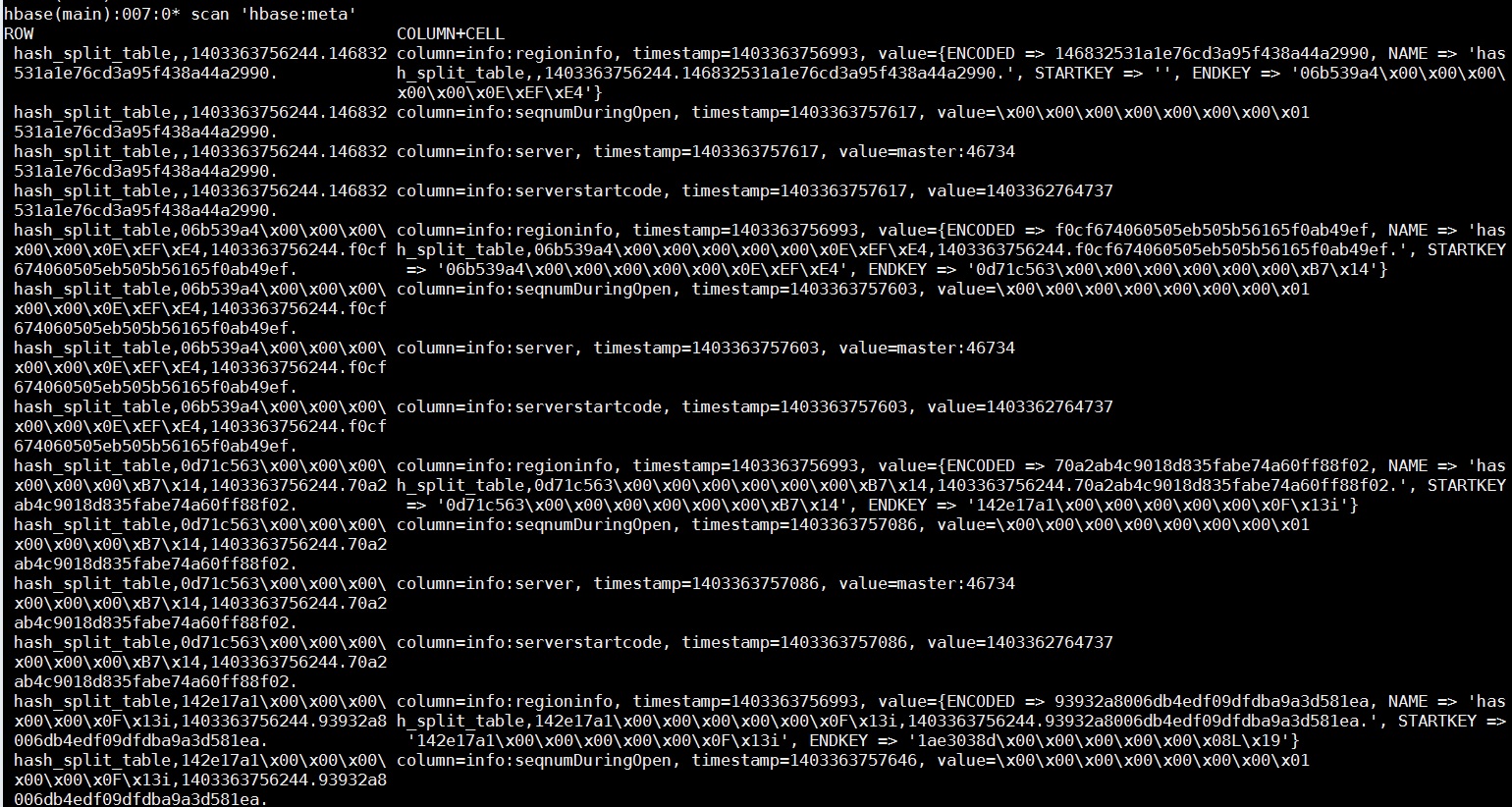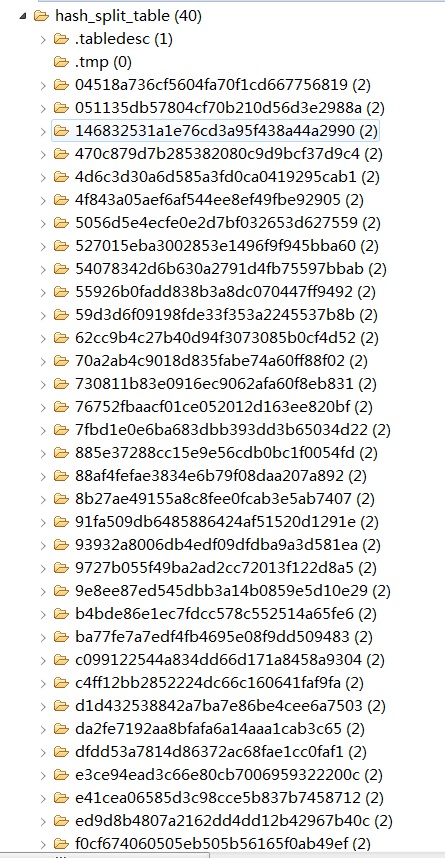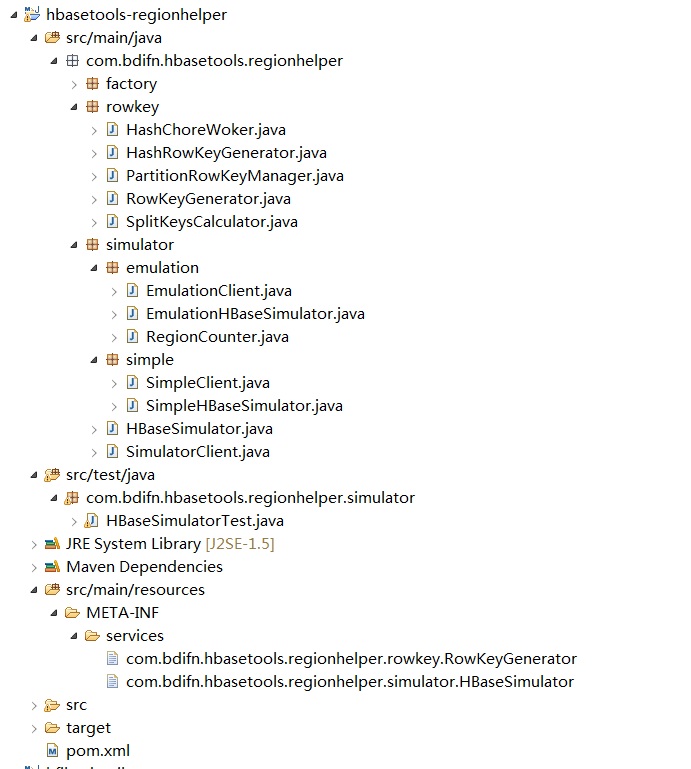HBase Rowkey的散列与预分区设计
转自:http://www.cnblogs.com/bdifn/p/3801737.html
问题导读:
1.如何防止热点?
2.如何预分区?
扩展:
为什么会产生热点存储?
HBase中,表会被划分为1...n个Region,被托管在RegionServer中。Region二个重要的属性:StartKey与EndKey表示这个Region维护的rowKey范围,当我们要读/写数据时,如果rowKey落在某个start-end key范围内,那么就会定位到目标region并且读/写到相关的数据。简单地说,有那么一点点类似人群划分,1-15岁为小朋友,16-39岁为年轻人,40-64为中年人,65岁以上为老年人。(这些数值都是拍脑袋出来的,只是举例,非真实),然后某人找队伍,然后根据年龄,处于哪个范围,就找到它所属的队伍。 : ( 有点废话了。。。。
然后,默认地,当我们只是通过HBaseAdmin指定TableDescriptor来创建一张表时,只有一个region,正处于混沌时期,start-end key无边界,可谓海纳百川。啥样的rowKey都可以接受,都往这个region里装,然而,当数据越来越多,region的size越来越大时,大到一定的阀值,hbase认为再往这个region里塞数据已经不合适了,就会找到一个midKey将region一分为二,成为2个region,这个过程称为分裂(region-split).而midKey则为这二个region的临界,左为N无下界,右为M无上界。< midKey则为阴被塞到N区,> midKey则会被塞到M区。
如何找到midKey?涉及的内容比较多,暂且不去讨论,最简单的可以认为是region的总行数 / 2 的那一行数据的rowKey.虽然实际上比它会稍复杂点。
如果我们就这样默认地,建表,表里不断地Put数据,更严重的是我们的rowkey还是顺序增大的,是比较可怕的。存在的缺点比较明显。
首先是热点写,我们总是会往最大的start-key所在的region写东西,因为我们的rowkey总是会比之前的大,并且hbase的是按升序方式排序的。所以写操作总是被定位到无上界的那个region中。
其次,由于写热点,我们总是往最大start-key的region写记录,之前分裂出来的region不会再被写数据,有点被打进冷宫的赶脚,它们都处于半满状态,这样的分布也是不利的。
如果在写比较频率的场景下,数据增长快,split的次数也会增多,由于split是比较耗时耗资源的,所以我们并不希望这种事情经常发生。
............
看到这些缺点,我们知道,在集群的环境中,为了得到更好的并行性,我们希望有好的load blance,让每个节点提供的请求处理都是均等的。我们也希望,region不要经常split,因为split会使server有一段时间的停顿,如何能做到呢?
随机散列与预分区。二者结合起来,是比较完美的,预分区一开始就预建好了一部分region,这些region都维护着自已的start-end keys,再配合上随机散列,写数据能均等地命中这些预建的region,就能解决上面的那些缺点,大大地提高了性能。
提供2种思路: hash 与 partition.
hash就是rowkey前面由一串随机字符串组成,随机字符串生成方式可以由SHA或者MD5等方式生成,只要region所管理的start-end keys范围比较随机,那么就可以解决写热点问题。
long currentId = 1L;
byte [] rowkey = Bytes.add(MD5Hash.getMD5AsHex(Bytes.toBytes(currentId)).substring(0, 8).getBytes(),
Bytes.toBytes(currentId));
假设rowKey原本是自增长的long型,可以将rowkey转为hash再转为bytes,加上本身id 转为bytes,组成rowkey,这样就生成随便的rowkey。那么对于这种方式的rowkey设计,如何去进行预分区呢?
1.取样,先随机生成一定数量的rowkey,将取样数据按升序排序放到一个集合里
2.根据预分区的region个数,对整个集合平均分割,即是相关的splitKeys.
3.HBaseAdmin.createTable(HTableDescriptor tableDescriptor,byte[][] splitkeys)可以指定预分区的splitKey,即是指定region间的rowkey临界值.
1.创建split计算器,用于从抽样数据中生成一个比较合适的splitKeys
public class HashChoreWoker implements SplitKeysCalculator{
//随机取机数目
private int baseRecord;
//rowkey生成器
private RowKeyGenerator rkGen;
//取样时,由取样数目及region数相除所得的数量.
private int splitKeysBase;
//splitkeys个数
private int splitKeysNumber;
//由抽样计算出来的splitkeys结果
private byte[][] splitKeys;
public HashChoreWoker(int baseRecord, int prepareRegions) {
this.baseRecord = baseRecord;
//实例化rowkey生成器
rkGen = new HashRowKeyGenerator();
splitKeysNumber = prepareRegions - 1;
splitKeysBase = baseRecord / prepareRegions;
}
public byte[][] calcSplitKeys() {
splitKeys = new byte[splitKeysNumber][];
//使用treeset保存抽样数据,已排序过
TreeSet<byte[]> rows = new TreeSet<byte[]>(Bytes.BYTES_COMPARATOR);
for (int i = 0; i < baseRecord; i++) {
rows.add(rkGen.nextId());
}
int pointer = 0;
Iterator<byte[]> rowKeyIter = rows.iterator();
int index = 0;
while (rowKeyIter.hasNext()) {
byte[] tempRow = rowKeyIter.next();
rowKeyIter.remove();
if ((pointer != 0) && (pointer % splitKeysBase == 0)) {
if (index < splitKeysNumber) {
splitKeys[index] = tempRow;
index ++;
}
}
pointer ++;
}
rows.clear();
rows = null;
return splitKeys;
}
}
KeyGenerator及实现
//interface
public interface RowKeyGenerator {
byte [] nextId();
}
//implements
public class HashRowKeyGenerator implements RowKeyGenerator {
private long currentId = 1;
private long currentTime = System.currentTimeMillis();
private Random random = new Random();
public byte[] nextId() {
try {
currentTime += random.nextInt(1000);
byte[] lowT = Bytes.copy(Bytes.toBytes(currentTime), 4, 4);
byte[] lowU = Bytes.copy(Bytes.toBytes(currentId), 4, 4);
return Bytes.add(MD5Hash.getMD5AsHex(Bytes.add(lowU, lowT)).substring(0, 8).getBytes(),
Bytes.toBytes(currentId));
} finally {
currentId++;
}
}
}
unit test case测试
@Test
public void testHashAndCreateTable() throws Exception{
HashChoreWoker worker = new HashChoreWoker(1000000,10);
byte [][] splitKeys = worker.calcSplitKeys();
HBaseAdmin admin = new HBaseAdmin(HBaseConfiguration.create());
TableName tableName = TableName.valueOf("hash_split_table");
if (admin.tableExists(tableName)) {
try {
admin.disableTable(tableName);
} catch (Exception e) {
}
admin.deleteTable(tableName);
}
HTableDescriptor tableDesc = new HTableDescriptor(tableName);
HColumnDescriptor columnDesc = new HColumnDescriptor(Bytes.toBytes("info"));
columnDesc.setMaxVersions(1);
tableDesc.addFamily(columnDesc);
admin.createTable(tableDesc ,splitKeys);
admin.close();
}
查看建表结果:执行 scan 'hbase:meta'

以上我们只是显示了部分region的信息,可以看到region的start-end key 还是比较随机散列的。同样可以查看hdfs的目录结构,的确和预期的38个预分区一致:

以上,就已经按hash方式,预建好了分区,以后在插入数据的时候,也要按照此rowkeyGenerator的方式生成rowkey,有兴趣的话,也可以做些试验,插入些数据,看看数据的分布。
partition故名思义,就是分区式,这种分区有点类似于mapreduce中的partitioner,将区域用长整数(Long)作为分区号,每个region管理着相应的区域数据,在rowKey生成时,将id取模后,然后拼上id整体作为rowKey.这个比较简单,不需要取样,splitKeys也非常简单,直接是分区号即可。直接上代码吧:
public class PartitionRowKeyManager implements RowKeyGenerator,
SplitKeysCalculator {
public static final int DEFAULT_PARTITION_AMOUNT = 20;
private long currentId = 1;
private int partition = DEFAULT_PARTITION_AMOUNT;
public void setPartition(int partition) {
this.partition = partition;
}
public byte[] nextId() {
try {
long partitionId = currentId % partition;
return Bytes.add(Bytes.toBytes(partitionId),
Bytes.toBytes(currentId));
} finally {
currentId++;
}
}
public byte[][] calcSplitKeys() {
byte[][] splitKeys = new byte[partition - 1][];
for(int i = 1; i < partition ; i ++) {
splitKeys[i-1] = Bytes.toBytes((long)i);
}
return splitKeys;
}
}
calcSplitKeys方法比较单纯,splitKey就是partition的编号,我们看看测试类:
@Test
public void testPartitionAndCreateTable() throws Exception{
PartitionRowKeyManager rkManager = new PartitionRowKeyManager();
//只预建10个分区
rkManager.setPartition(10);
byte [][] splitKeys = rkManager.calcSplitKeys();
HBaseAdmin admin = new HBaseAdmin(HBaseConfiguration.create());
TableName tableName = TableName.valueOf("partition_split_table");
if (admin.tableExists(tableName)) {
try {
admin.disableTable(tableName);
} catch (Exception e) {
}
admin.deleteTable(tableName);
}
HTableDescriptor tableDesc = new HTableDescriptor(tableName);
HColumnDescriptor columnDesc = new HColumnDescriptor(Bytes.toBytes("info"));
columnDesc.setMaxVersions(1);
tableDesc.addFamily(columnDesc);
admin.createTable(tableDesc ,splitKeys);
admin.close();
}
同样我们可以看看meta表和hdfs的目录结果,其实和hash类似,region都会分好区,在这里就不上图了。
通过partition实现的loadblance写的话,当然生成rowkey方式也要结合当前的region数目取模而求得,大家同样也可以做些实验,看看数据插入后的分布。
在这里也顺提一下,如果是顺序的增长型原id,可以将id保存到一个数据库,传统的也好,redis的也好,每次取的时候,将数值设大1000左右,以后id可以在内存内增长,当内存数量已经超过1000的话,再去load下一个,有点类似于oracle中的sqeuence.
随机分布加预分区也不是一劳永逸的。因为数据是不断地增长的,随着时间不断地推移,已经分好的区域,或许已经装不住更多的数据,当然就要进一步进行split了,同样也会出现性能损耗问题,所以我们还是要规划好数据增长速率,观察好数据定期维护,按需分析是否要进一步分行手工将分区再分好,也或者是更严重的是新建表,做好更大的预分区然后进行数据迁移。小吴只是菜鸟,运维方面也只是自已这样认为而已,供大家作简单的参考吧。如果数据装不住了,对于partition方式预分区的话,如果让它自然分裂的话,情况分严重一点。因为分裂出来的分区号会是一样的,所以计算到partitionId的话,其实还是回到了顺序写年代,会有部分热点写问题出现,如果使用partition方式生成主键的话,数据增长后就要不断地调整分区了,比如增多预分区,或者加入子分区号的处理.(我们的分区号为long型,可以将它作为多级partition)
OK,写到这里,基本已经讲完了防止热点写使用的方法和防止频繁split而采取的预分区。但rowkey设计,远远也不止这些,比如rowkey长度,然后它的长度最大可以为char的MAXVALUE,但是看过之前我写KeyValue的分析知道,我们的数据都是以KeyValue方式存储在MemStore或者HFile中的,每个KeyValue都会存储rowKey的信息,如果rowkey太大的话,比如是128个字节,一行10个字段的表,100万行记录,光rowkey就占了1.2G+所以长度还是不要过长,另外设计,还是按需求来吧。
最后题外话是我想分享我在github中建了一个project,希望做一些hbase一些工具:https://github.com/bdifn/hbase-tools,如果本地装了git的话,可以执行命令: git clone https://github.com/bdifn/hbase-tools.git目前加了一个region-helper子项目,也是目前唯一的一个子项目,项目使用maven管理,主要目的是帮助我们设计rowkey做一些参考,比如我们设计的随机写和预分区测试,提供了抽样的功能,提供了检测随机写的功能,然后统计按目前rowkey设计,随机写n条记录后,统计每个region的记录数,然后显示比例等。
测试仿真模块我程为simualtor,主要是模拟hbase的region行为,simple的实现,仅仅是上面提到的预测我们rowkey设计后,建好预分区后,写数据的的分布比例,而emulation是比较逼真的仿真,设想是我们写数据时,会统计数目的大小,根据我们的hbase-site.xml设定,模拟memStore行为,模拟hfile的行为,最终会生成一份表的报表,比如分区的数据大小,是否split了,等等,以供我们去设计hbase表时有一个参考,但是遗憾的是,由于时间关系,我只花了一点业余时间简单搭了一下框架,目前没有更一步的实现,以后有时间再加以完善,当然也欢迎大家一起加入,一起学习吧。

项目使用maven管理,为了方便测试,一些组件的实例化,我使用了java的SPI,download源码后,如果想测试自已的rowKeyGeneator的话,打开com.bdifn.hbasetools.regionhelper.rowkey.RowKeyGenerator文件后,替换到你们的ID生成器就可以了。如果是hash的话,抽样和测试等,都是可以复用的。
如测试代码:
public class HBaseSimulatorTest {
//通过SPI方式获取HBaseSimulator实例,SPI的实现为simgple
private HBaseSimulator hbase = BeanFactory.getInstance().getBeanInstance(HBaseSimulator.class);
//获取RowKeyGenerator实例,SPI的实现为hashRowkey
private RowKeyGenerator rkGen = BeanFactory.getInstance().getBeanInstance(RowKeyGenerator.class);
//初如化苦工,去检测100w个抽样rowkey,然后生成一组splitKeys
HashChoreWoker worker = new HashChoreWoker(1000000,10);
@Test
public void testHash(){
byte [][] splitKeys = worker.calcSplitKeys();
hbase.createTable("user", splitKeys);
//插入1亿条记录,看数据分布
TableName tableName = TableName.valueOf("user");
for(int i = 0; i < 100000000; i ++) {
Put put = new Put(rkGen.nextId());
hbase.put(tableName, put);
}
hbase.report(tableName);
}
@Test
public void testPartition(){
//default 20 partitions.
PartitionRowKeyManager rkManager = new PartitionRowKeyManager();
byte [][] splitKeys = rkManager.calcSplitKeys();
hbase.createTable("person", splitKeys);
TableName tableName = TableName.valueOf("person");
//插入1亿条记录,看数据分布
for(int i = 0; i < 100000000; i ++) {
Put put = new Put(rkManager.nextId());
hbase.put(tableName, put);
}
hbase.report(tableName);
}
}
执行结果:
Execution Reprort:[StartRowkey:puts requsts:(put ratio)] :9973569:(1.0015434) 1986344a\x00\x00\x00\x00\x00\x01\x0E\xAE:9999295:(1.0041268) 331ee65f\x00\x00\x00\x00\x00\x0F)g:10012532:(1.005456) 4cbfd4f6\x00\x00\x00\x00\x00\x00o0:9975842:(1.0017716) 664c6388\x00\x00\x00\x00\x00\x02\x1Du:10053337:(1.0095537) 800945e0\x00\x00\x00\x00\x00\x01\xADV:9998719:(1.0040689) 99a158d9\x00\x00\x00\x00\x00\x0BZ\xF3:10000563:(1.0042541) b33a2223\x00\x00\x00\x00\x00\x07\xC6\xE6:9964921:(1.000675) ccbcf370\x00\x00\x00\x00\x00\x00*\xE2:9958200:(1.0) e63b8334\x00\x00\x00\x00\x00\x03g\xC1:10063022:(1.0105262) total requests:100000000 Execution Reprort:[StartRowkey:puts requsts:(put ratio)] :5000000:(1.0) \x00\x00\x00\x00\x00\x00\x00\x01:5000000:(1.0) \x00\x00\x00\x00\x00\x00\x00\x02:5000000:(1.0) \x00\x00\x00\x00\x00\x00\x00\x03:5000000:(1.0) \x00\x00\x00\x00\x00\x00\x00\x04:5000000:(1.0) \x00\x00\x00\x00\x00\x00\x00\x05:5000000:(1.0) \x00\x00\x00\x00\x00\x00\x00\x06:5000000:(1.0) \x00\x00\x00\x00\x00\x00\x00\x07:5000000:(1.0) \x00\x00\x00\x00\x00\x00\x00\x08:5000000:(1.0) \x00\x00\x00\x00\x00\x00\x00\x09:5000000:(1.0) \x00\x00\x00\x00\x00\x00\x00\x0A:5000000:(1.0) \x00\x00\x00\x00\x00\x00\x00\x0B:5000000:(1.0) \x00\x00\x00\x00\x00\x00\x00\x0C:5000000:(1.0) \x00\x00\x00\x00\x00\x00\x00\x0D:5000000:(1.0) \x00\x00\x00\x00\x00\x00\x00\x0E:5000000:(1.0) \x00\x00\x00\x00\x00\x00\x00\x0F:5000000:(1.0) \x00\x00\x00\x00\x00\x00\x00\x10:5000000:(1.0) \x00\x00\x00\x00\x00\x00\x00\x11:5000000:(1.0) \x00\x00\x00\x00\x00\x00\x00\x12:5000000:(1.0) \x00\x00\x00\x00\x00\x00\x00\x13:5000000:(1.0) total requests:100000000
原贴地址:http://www.cnblogs.com/bdifn/p/3801737.html ,转载请注明





